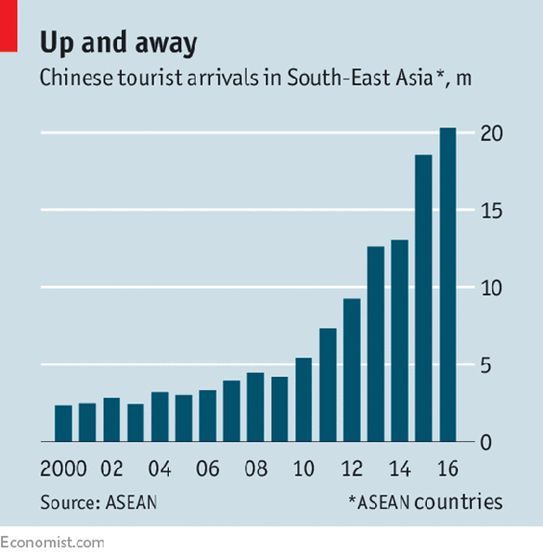East Asia has the world’s fastest growing tourist industry
The number of Chinese visitors to South-East Asia has quadrupled in the past decade
Apr 12th 2018 | Singapore
THE view from the top of Marina BaySands, a giant hotel, mall and casino, takes in the skyscrapers of Singapore,the fleets of ships entering and leaving the city’s ports, the scattered tropical islands of the Singapore Strait and the crowds of soggy but determined selfie-takers trying to capture a perfect image of it all fromthe enormous infinity pool.Among the celebrities the hotel has lured for a damp snap are Jing Boran and Fu Xinbo, Chinese film and music stars. China Daily, a Chinese state-owned newspaper, has declared the spot the eighth most romantic in the world. The place displays itself all over Chinese social media and offers special discounts and packages to visitors from China.
Such spin is increasingly important.Last year, for the first time, China was the biggest source of tourists to Singapore, accounting for 3.2m of its 17.4m visitors. Between January and September alone they spent more than S$3bn ($2.3bn).
新加坡Marina Bay Sands酒店楼顶的无边界泳池,在中国的社交媒体上特别火,China Daily还介绍它是世界八大浪漫的地点之一。中国游客是新加坡游客第一大来源,1740万人中有320万来自中国!
All across South-East Asia, tourism is booming. The number of visitors jumped by 49% between 2010 and 2015, to more than 109m. Tourism in Asia and the Pacific is growing faster than anywhere else in the world. The region receives a quarter of the world’s holidaymakers(Europe’s share is still a half).
South-East Asia’s Edenic islands, ancient temples and delicious food are strong enticements. Visitors also flock to countries with cheap currencies: the weakness of the ringgit last year helped draw visitors to Malaysia, for example. Many countries in the region depend on the cash: tourism accounts for about 28% of Cambodia’s GDP and more than 20% of Thailand’s.
ringgit:the Malaysian ringgit, symbol RM 马来西亚的货币
东南亚旅游市场是增长最快的,从2010年到2015年,游客数量增长了49%,比世界其他任何地方都增长地快!
The most remarkable growth has been in tourists from China. The number visiting South-East Asia has increased fivefold over the past decade (see chart).Newly wealthy Chinese spent almost $261bn travelling abroad in 2016, up from $73bn in 2011.
Indonesia, for one, has relaxed its visa rules to attract more of them. More seats on cheap flights have also helped pull in tourists: between 2013 and 2016 the number available each week on flights to South-East Asia from China increased from 92,000 to 188,500.
But for the frenzied holidaying to continue to grow, infrastructure must improve, reckons Paul Yong of DBS, a Singaporean bank. Airports in places such as Manila and Jakarta are crumbling and surrounded by snaking traffic. Plans are afoot to increase annual capacity at Bangkok’s airports by tens of millions over the next four years. Hanoi’s NoiBai will be expanded at a cost of $5.5bn to accommodate 35m passengers by 2020.Airports in Singapore and Kuala Lumpur are to be upgraded too.
Other threats to thriving tourism are far harder to plan around. Travel operators tremble at the thought of economic downturns, volcanic eruptions and epidemic diseases. The head of one luxury holiday company says the regional outbreak of SARS, a respiratory disease, more than 15 years ago almost brought the industry to its knees. Political spats between China and its neighbours are another problem. So too is the manner in which Chinese visitors have been vilified in the region for snaffling prawns at buffets, barging into queues and misbehaving on planes. It makes many of them feel unwanted. But given that just 135m of China’s 1.4bn people have ever travelled abroad, South-East Asian countries should prepare to welcome many more Chinese—even when they clog up the infinity pool.
respiratory: of or relating to breathing or the organs of the body that are used in breathing
中国游客的部分不文明行为使中国游客不那么吸引了,但是他们中的很多人都是第一次出国,也就能理解了
总结:世界各地都在迎接更多的中国游客,和期盼着他们消费!
--------------------------------------------------------------------------------------------------------------------
Results
Lexile®Measure: 1100L - 1200L
Mean Sentence Length: 16.14
Mean Log Word Frequency: 3.13
Word Count: 565
这篇文章的蓝思值是在1100-1200L, 是经济学人里普通难度的文章~
使用kindle断断续续地读《经济学人》三年,发现从一开始磕磕碰碰到现在比较顺畅地读完,进步很大,推荐购买!点击这里可以去亚马逊官网购买~

